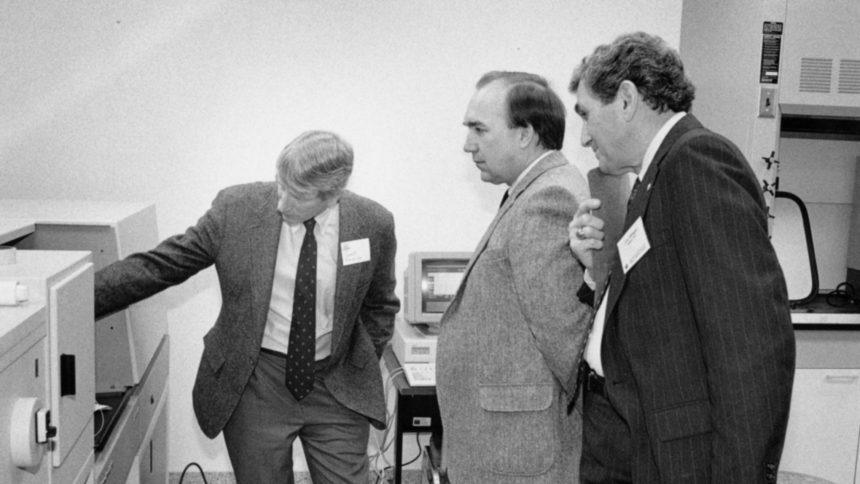In January 1990, the MSU Board of Trustees approved the creation of the Population Medicine Center in the college. Population medicine involves an integrated approach to dealing with population-based public health and animal health problems, according to Dr. John Kaneene, who was named the center's director.
Among the significant happenings in the 1990s were the visit by the accrediting body of the American Veterinary Medical Association, completion of new facilities, revision of the curriculum, and transition to the semester system.
The accreditation site visit took place October 28-31, 1990. At its spring meeting in March 1991, the AVMA Council on Education voted to return the college to full accreditation for a two-year period. One year later, the council voted to extend full accreditation to 1998.

The new building formally opened on January 26, 1991, at a dedication ceremony attended by Governor John Engler, MSU President John DiBiaggio and other dignitaries. The three-story, 72,000-square-foot facility was added to the southeast corner of the existing Veterinary Clinical Center.

It provided space for teaching, research, animal care, and administrative offices. Also included in the project were renovation and expansion of the existing Veterinary Clinical Center. That project, completed in 1992, provided improved clinical facilities for large and small animals, including new emergency and intensive care units, a new anesthesia preparation area, as well as new large- and small-animal surgery, radiology, pharmacy, and clinical pathology facilities.
In recognition of these changes in the college's facilities, the name "Veterinary Clinical Center" was retired. The renovated clinical areas are now called the Veterinary Medical Center and the entire complex was renamed the Veterinary Medical Center (VMC) effective September 1991.
A new curriculum was approved by the faculty on April 30, 1991. With the inauguration of the university-wide semester system, the college chose to move away from a fact-driven curriculum to one that stressed problem solving. The new curriculum promoted active learning by having students participate in problem-solving exercises from the very beginning of their academic careers. It also allowed for more elective course flexibility in the last four semesters of the program. The university officially switched to a semester system in September 1992.
After an extensive search, Dr. Steven P. Arnoczky was selected as the first incumbent of the Wade O. Brinker Chair of Veterinary Surgery. He began his appointment on January 6, 1992. He brought with him the Laboratory for Comparative Orthopaedic Research, the main focus of which is the investigation of the basic science of musculoskeletal disorders common to people and animals.
Several changes in administrative personnel occurred in the '90s. Dr. Willie M. Reed replaced Dr. Kenneth K. Keahey as director of the Animal Health Diagnostic Laboratory following his retirement on December 31, 1990. After serving as dean for nine years, Dr. John Tasker stepped down on October 1, 1993. Dr. Wally Keller was appointed acting dean, effective that date.
There were also a number of organizational changes in the teaching hospital including the appointment of a Veterinary Services Advisory Board and the naming of two chiefs of staff—Dr. Cheri A. Johnson, chief of staff of the Small Animal Teaching Hospital, and Dr. John A. Stick, chief of staff of the Large Animal Teaching Hospital.
The university's first major Capital Campaign concluded successfully on March 31, 1993. The college once again benefited from the financial support of alumni and friends, netting $2,679,405 over the course of the three-year campaign. At that time the College had the second largest endowment of any college at Michigan State and received the largest amount of new deferred gift commitments over the previous five years of any MSU college. This support was especially needed and appreciated in a time when the college was striving to maintain the integrity of its mission in the face of ever-increasing budget reduction targets imposed by the university.
In 1994, the college launched the Miracle of Life Animal Birthing Exhibit at the Michigan State Fair, and it was one of the most popular exhibits ever. It was hailed by the governor, surrounded by media, and very nearly overrun by 60,000 enthusiastic visitors.
On April 13, 1995, Dr. Waldo Keller was appointed dean of the College, after serving as acting dean for a year and-a-half. Dr. Lonnie King, a long-time administrator with the U.S. Department of Agriculture, was named the new dean of the College on July 1, 1996.
The Mary Anne McPhail Dressage Chair in Equine Sports Medicine was established in January 1996 thanks to a generous donation from Mary Anne and Walter McPhail. The McPhail Chair, the only one of its kind in the world, was envisioned to be a national resource devoted to the health needs of the high-caliber dressage horse. One of the goals of the new endowed chair was to improve both the treatment and prevention of health problems in equine athletes. Mary Anne McPhail is a 1955 graduate of MSU and an accomplished horsewoman and international dressage judge, Her husband, Walter, is a retired chief executive officer of Lectron Products of Troy, Mich.
Dr. Hilary Clayton, a veterinarian and one of the world's top authorities on dressage, accepted the invitation to fill the Mary Anne McPhail Dressage Chair in Equine Sports Medicine. Her appointment was effective July 1, 1997.
In August 1997, the Scott Charitable Trust gave a $200,000 gift to the College to help fund a new approach to teaching surgery in order to further reduce the number of live animals used in the surgical instruction of veterinary students. The gift was used to support a three-pronged approach, including an expanded spay/neuter program with the local humane society and animal shelters.
In April 1998, the College won the 1998 All-University Excellence in Diversity Award. This was the first time that an entire college had achieved this status. The College had a number of outstanding programs and projects in place that promoted diversity and had been recognized nationally for its innovative and successful activities.
The Department of Physiology celebrated the department's 75th anniversary with a series of seminars and special events during the fall of 1998.
Twenty-five years of effort culminated October 24, 1998 with the dedication of the Food Safety and Toxicology Building. The building was to house researchers with expertise in toxicology, carcinogenesis, pathology, bioanalytical chemistry, microbiology, and epidemiology. Research conducted there was intended to increase the understanding of chemical and microbial hazards in foods. The goal was to use this knowledge to develop a safer food supply, well-founded public policy, and greater public understanding of food safety issues.
The Academic Programs and Student Services Center opened at the College in November 1999 with the purpose of streamlining support for students in the professional program.
The love of dogs and Michigan State University is what prompted two former Michigan residents to establish a charitable bequest to the College for canine health research. In 1999, Don Myers and Bill Dunlap bequeathed $3 million for the Donald R. Myers and William E. Dunlap Endowed Chair in Canine Health.
The Matilda R. Wilson Fund established another endowed chair in the College in the winter of 2000. The Meadow Brook Farm Animal Chair in the Department of Large Animal Clinical Sciences would focus on enhancing and ensuring the health, nutrition, and well-being of farm animals—lifetime goals of Matilda Wilson.
